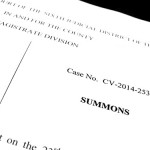Dan Snyder is easy to mock. I will probably do it in this post. So when he filed his lawsuit against the Washington City Paper for defamation, I instinctively rolled my eyes. So did you. We all did.
Motion to Enforce Settlement: Medicare Liens
I’ve never filed a motion to enforce a settlement and I don’t think anyone in my firm has. I think as far as I’ve come is threatening to file a motion, but it never comes to that.
That streak may not survive as insurance companies continue to overreact to their risk of Medicare or Medicare coming back to haunt them after a settlement. Sure, there are theoretical potential penalties if Medicare and/or Medicaid liens are not dealt with out of the settlement funds. I don’t have a problem with insurance companies trying to reduce their small risk. But some insurance adjusters handling claims in Maryland are cementing their reputation of being unreasonable by taking extreme positions on what post-settlement hoops plaintiffs’ lawyers must jump through to get a check.
Torts Talk, a defense lawyer oriented blog I just stumbled upon, talks about how a Pennsylvania judge dealt with this issue. Plaintiff’s attorney filed a Motion to Enforce a Settlement when the insurance company refused to issue a settlement check after a car accident settlement until the Plaintiff produced documentation confirming the status of any Medicare/Medicaid lien.
Attacking Plaintiffs’ Malpractice Experts
John T. Sly and Christina N. Billiet from Waranch & Brown write an article for the Maryland Defense Counsel newsletter about how to best attack plaintiffs’ experts out of the gate. One key tactic they advise is trying to get two depositions of the plaintiffs’ medical expert. Interestingly, they name drop the judges they say have approved this tactic and ordered plaintiffs’ experts to sit through two depositions: Judges Leo E. Green and Thomas P. Smith, both in Prince George’s County.
Malpractice Reform: New England Journal of Medicine
It kills me how so many folks hold up the New England Journal of Medicine as the gold standard for anything and everything until it speaks up about preemption or medical malpractice reform. Then they become hacks for… well, nobody, really. Just hacks.
The NEJM put out a recent article that looked at traditional malpractice tort reform:
Our review yielded two main conclusions. First, evaluations of traditional tort reforms have remained heavily focused on metrics related to liability costs, with most care-related measures receiving relatively short shrift. Second, the evidence reveals that, with few exceptions, traditional tort reforms have not proved to provide many improvements in these liability metrics.
So we have decided as a society in many jurisdictions, including Maryland, to limit how its citizen juries can award and deprive malpractice victims sometimes what we would all agree to be the fair value of the injuries or death because of the case’s true value exceeds the malpractice cap. Oh, yeah, we also look the other way on the Constitution’s due process and equal protection requirements. Continue reading
Sham Affidavits: New 10th Circuit Opinion
The 10th Circuit yesterday decided a Ford F-150 product defect case in which it reversed the trial court’s entry of summary judgment but sent the case back down to the District Court. I love it when courts do that.
The issue in this wrongful death case was whether plaintiffs’ expert could flip his deposition testimony after getting boxed into a causation corner. The 10th Circuit said they could not, adopting a line from the District Court that I like: “[Plaintiffs] treated the deposition as a ‘take home examination.'”
This case’s issue is like the issue addressed in Pittman v. Atlantic Realty, a lead paint case I won on summary judgment for the defendant before Baltimore City Circuit Court Judge David B. Mitchell that was reversed by the Maryland Court of Appeals.
I started my argument in Pittman with this line about how the Plaintiffs were delivering their case the way Nathaniel Hawthorne delivered his novels; sending out one chapter at a time. I thought it was so clever. Boy, I was stupid. (And I don’t even think I ever completed the full Cliff Notes of a Hawthorne novel.) I could have saved 10 pages of transcript by saying, “Plaintiffs treated this case like a take-home deposition.” Still, I won.
Excitement About Frivolous Lawsuits
Is it just me or does every get excited seeing everyone’s crazy aunts and uncles come out of the basement and try to top each other with a more ridiculous, insane proposals for dealing with frivolous lawsuits? The Overlawyered commenters are out and about after reports of a lawsuit over the right to wear unbelievably awful t-shirts to public school.
Can I play too? We should execute anyone who we suspect is thinking of filing a frivolous lawsuit. There is a precedent for this. Remember the Minority Report?
I agree with the implied premise of the post that people shouldn’t be filing lawsuits defending the right of kids to wear offensive t-shirts to a public school. (Particularly if the girl’s parents are making her wear the shirt. Good golly.) Truly, it is a beyond insane lawsuit. It should be renounced. (I guess. We could also just look away, I suppose. We have 300 million people in this county. Do we have to report on every random idiot who burns the Koran?)
But the feeding frenzy that follows reports of these outlier cases operates under the assumption that frivolous lawsuits are the rule rather than the exception. The “free market” that I’m sure the commenters idolize takes care of lawyers who are recidivist filers of frivolous lawsuits: it puts them out of business. Continue reading
Sexting/Suicide Leads to Lawsuit
The parents of a 13-year-old girl that committed suicide have sued a school system alleging the school should have been able to prevent her suicide.
Teenagers have been taking their own lives as long as history can remember. This tragedy has a modern twist. The girl did something that lots of young people are doing now: sexting. She texted a topless photo of herself to a boy. You know what happened. Teenage boys are not known for their discretion. Then the media picks up the story. Now, they don’t name names but anyone within 5 miles of the girl knows who it is. All of this culminates in the girl’s suicide. The parents’ wrongful death lawsuit alleges the school did not do enough to prevent the girl from committing suicide.
GEICO Just Kills Me
I settled a case with GEICO. They send me – personally – a Hold Harmless and Indemnification Agreement holding them harmless from any claims for medical liens, medical bills, and pretty much any claim that could be brought of any kind before they will send out a settlement check. My client and I are on the release. But there is just one signature line.
I told the adjuster, “Look, we already settled the case. Now you are putting conditions on a new party, namely me. That seems reasonable enough. But are you willing personally to throw $100 into the settlement yourself? That is my new condition.”
I thought this was funny and illustrative. The GEICO claims adjuster? Less so. Instead, he rolls off a list of lawyers who have signed this hold harmless agreement. Literally, it was like a who’s who list of “prolific” Maryland tort attorneys, most advertisers, who have been around forever and I believe have never tried a serious personal injury case in their lives. Just funny he would be name dropping those lawyers.
Five Things You May Not Know About Liens
I read somewhere recently that making Top Ten lists really attracts readers. Regrettably, I don’t know ten things about fighting medical liens that I think you don’t know. But I know a few.
I’ve been working harder and harder, trying to better understand the ins and outs of subrogation liens that arise in personal injury cases. With some of the larger cases, we farm out lien work to firms that focus only on resolving lien issues. But there are so many basic things I think personal injury lawyers need to appreciate about lien issues. Anyway, here is my Top Five list:
1. The mere fact that it is an ERISA lien does not automatically mean that the lien cannot be reduced for attorneys’ fees. Subrogation and reimbursement rights for ERISA insurance plans only exist if the language of the plan says they do. You have to actually read the plan to know.
Property Damage Claims Releases
Before a client executes a release or signs a check for a property damage claim, I want to review the release if they have a potential personal injury claim from the accident. Particularly in uninsured motorist cases, but this paranoia extends to every type of accident case.
Why? I don’t want the insurance company to pull a fast one and slip in a full release under the guise of a property damage release for the client’s car.
In years past, after looking at approximately one zillion property damage releases, the Oliver Stone conspiracy has never come to pass. Insurance companies have always been straight with me. Until this week… Continue reading



